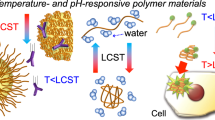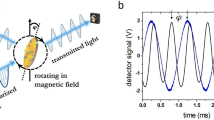Abstract
Many medical and biotechnological processes rely on controlling and manipulating the molecular-recognition capabilities of proteins1,2,3,4. This can be achieved using small molecules capable of competing for protein binding or by changing environmental parameters that affect protein structure and hence binding. An alternative is provided by stimuli-responsive polymers that change reversibly from a water-soluble expanded coil to a water-insoluble collapsed globule upon small changes in temperature, pH or light intensity: when attached to proteins in the vicinity of their binding sites, they reversibly block and release small ligands1,5,6,7. Here we show how this approach can be extended to achieve size-selective binding of large, macromolecular ligands. We use the thermally responsive polymer poly(N,N-diethylacrylamide) (PDEAAm), and attach it to the protein streptavidin approximately 20 Å from the binding site for biotinylated proteins. Below the lower critical solution temperature of PDEAAm, the polymer is in its extended state and acts as a ‘shield’ to block the binding of large biotinylated proteins; above this temperature, it collapses and exposes the binding site, thereby allowing binding. We find that the degree of shielding depends on both the size of the biotinylated protein and the size of PDEAAm, suggesting that ‘smart’ polymer shields could be tailored to achieve a wide range of size-dependent ligand discrimination for use in affinity separations, biosensors and diagnostics technologies.
This is a preview of subscription content, access via your institution
Access options
Subscribe to this journal
Receive 51 print issues and online access
$199.00 per year
only $3.90 per issue
Buy this article
- Purchase on Springer Link
- Instant access to full article PDF
Prices may be subject to local taxes which are calculated during checkout





Similar content being viewed by others
References
Fong, R. B., Ding, Z., Long, C. J., Hoffman, A. S. & Stayton, P. S. Thermoprecipitation of streptavidin via oligonucleotide-mediated self-assembly with poly(N-isopropylacrylamide). Bioconj. Chem. 10, 720–725 (1999).
Wilchek, M. & Bayer, E. A. Avidin–Biotin Technology (Academic, New York, 1990)
Schlosser, M., Hahmann, J., Ziegler, B., Augstein, P. & Ziegler, M. Sensitive monoclonal antibody-based sandwich ELISA for determination of the diabetes-associated autoantigen glutamic acid decarboxylase GAD65. J. Immunoass. 18, 289–307 (1997).
Bloch, B. Biotinylated probes for in situ hybridization histochemistry: Use for mRNA detection. J. Histochem. Cytochem. 41, 1751–1754 (1993).
Stayton, P. S. et al. Control of protein-ligand recognition using a stimuli-responsive polymer. Nature 378, 472–474 (1995).
Bulmus, V., Ding, Z., Long, C. J., Stayton, P. S. & Hoffman, A. S. Design, synthesis and site-specific conjugation of a pH- and temperature-sensitive polymer to streptavidin for pH-controlled binding and triggered release of biotin. Bioconj. Chem. 11, 78–83 (1999).
Ding, Z . et al. Temperature control of biotin binding and release with a streptavidin-poly(N-isopropylacrylamide) site-specific conjugate. Bioconj. Chem. 10, 395–400 (1999).
Wu, C. & Wang, X. H. Globule-to-coil transition of a single homopolymer chain in solution. Phys. Rev. Lett. 80, 4092–4094 (1998).
Sogah, D. Y., Hertler, W. R., Webster, O. W. & Cohen, G. M. Group transfer polymerization. Polymerization of acrylic monomers. Macromolecules 20, 1473–1488 (1987).
Hofmann, K., Wood, S. A., Brinton, C. C., Montibeller, J. A. & Finn, F. M. Iminobiotin affinity columns and their application to retrieval of streptavidin. Proc. Natl Acad. Sci. USA 77, 4666–4668 (1980).
Acknowledgements
We thank R. Clark for providing protein G, and N. Murthy for help with PDEAAm synthesis. This work was supported by the National Institutes of Health.
Author information
Authors and Affiliations
Rights and permissions
About this article
Cite this article
Ding, Z., Fong, R., Long, C. et al. Size-dependent control of the binding of biotinylated proteins to streptavidin using a polymer shield. Nature 411, 59–62 (2001). https://doi.org/10.1038/35075028
Received:
Accepted:
Issue Date:
DOI: https://doi.org/10.1038/35075028
This article is cited by
-
Submonolayer biolasers for ultrasensitive biomarker detection
Light: Science & Applications (2023)
-
Rational Design of Biomolecules/Polymer Hybrids by Reversible Deactivation Radical Polymerization (RDRP) for Biomedical Applications
Chinese Journal of Polymer Science (2021)
-
Electroosmotic flow and transport of ionic species through a slit soft nanochannel filled with general electrolytes
Meccanica (2019)
-
Electroosmotic flow reversal and ion selectivity in a soft nanochannel
Colloid and Polymer Science (2018)
-
Cell-permeable capsids as universal antigen carrier for the induction of an antigen-specific CD8+ T-cell response
Scientific Reports (2017)
Comments
By submitting a comment you agree to abide by our Terms and Community Guidelines. If you find something abusive or that does not comply with our terms or guidelines please flag it as inappropriate.



